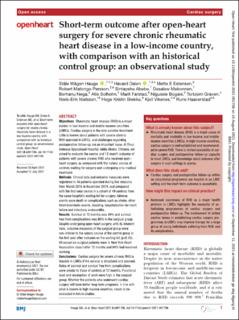| dc.contributor.author | Hauge, Ståle Wågen | |
| dc.contributor.author | Dalen, Havard | |
| dc.contributor.author | Estensen, Mette-Elise | |
| dc.contributor.author | Persson, Robert Matongo | |
| dc.contributor.author | Abebe, Sintayehu | |
| dc.contributor.author | Mekonnen, Desalew | |
| dc.contributor.author | Nega, Berhanu | |
| dc.contributor.author | Solholm, Atle | |
| dc.contributor.author | Farstad, Marit | |
| dc.contributor.author | Bogale, Nigussie | |
| dc.contributor.author | Graven, Torbjorn | |
| dc.contributor.author | Nielssen, Niels-Erik | |
| dc.contributor.author | Brekke, Hege Kristin | |
| dc.contributor.author | Vikenes, Kjell | |
| dc.contributor.author | Haaverstad, Rune | |
| dc.date.accessioned | 2021-09-13T07:38:09Z | |
| dc.date.available | 2021-09-13T07:38:09Z | |
| dc.date.created | 2021-09-01T12:44:36Z | |
| dc.date.issued | 2021 | |
| dc.identifier.citation | Open heart. 2021, 8 (2), 1-9. | en_US |
| dc.identifier.issn | 2053-3624 | |
| dc.identifier.uri | https://hdl.handle.net/11250/2775355 | |
| dc.description.abstract | Objectives Rheumatic heart disease (RHD) is a major burden in low-income and middle-income countries (LMICs). Cardiac surgery is the only curative treatment. Little is known about patients with severe chronic RHD operated in LMICs, and challenges regarding postoperative follow-up are an important issue. At Tikur Anbessa Specialised Hospital, Addis Ababa, Ethiopia, we aimed to evaluate the course and 12-month outcome of patients with severe chronic RHD who received open-heart surgery, as compared with the natural course of controls waiting for surgery and undergoing only medical treatment. Methods Clinical data and outcome measures were registered in 46 patients operated during five missions from March 2016 to November 2019, and compared with the first-year course in a cohort of 49 controls from the same hospital’s waiting list for surgery. Adverse events were death or complications such as stroke, other thromboembolic events, bleeding, hospitalisation for heart failure and infectious endocarditis. Results Survival at 12 months was 89% and survival free from complications was 80% in the surgical group. Despite undergoing open-heart surgery, with its inherent risks, outcome measures of the surgical group were non-inferior to the natural course of the control group in the first year after inclusion on the waiting list (p≥0.45). All except six surgical patients were in New York Heart Association class I after 12 months and 84% had resumed working. Conclusions Cardiac surgery for severe chronic RHD is feasible in LMICs if the service is structured and planned. Rates of survival and survival free from complications were similar to those of controls at 12 months. Functional level and resumption of work were high in the surgical group. Whether the patients who underwent cardiac surgery will have better long-term prognosis, in line with what is known in high-income countries, needs to be evaluated in future studies. | en_US |
| dc.language.iso | eng | en_US |
| dc.publisher | BMJ Publishing Group | en_US |
| dc.rights | Navngivelse 4.0 Internasjonal | * |
| dc.rights.uri | http://creativecommons.org/licenses/by/4.0/deed.no | * |
| dc.title | Short-term outcome after open-heart surgery for severe chronic rheumatic heart disease in a low-income country, with comparison with an historical control group: An observational study | en_US |
| dc.type | Peer reviewed | en_US |
| dc.type | Journal article | en_US |
| dc.description.version | publishedVersion | en_US |
| dc.source.pagenumber | 1-9 | en_US |
| dc.source.volume | 8 | en_US |
| dc.source.journal | Open heart | en_US |
| dc.source.issue | 2 | en_US |
| dc.identifier.doi | 10.1136/openhrt-2021-001706 | |
| dc.identifier.cristin | 1930440 | |
| cristin.ispublished | true | |
| cristin.fulltext | original | |
| cristin.qualitycode | 1 | |

